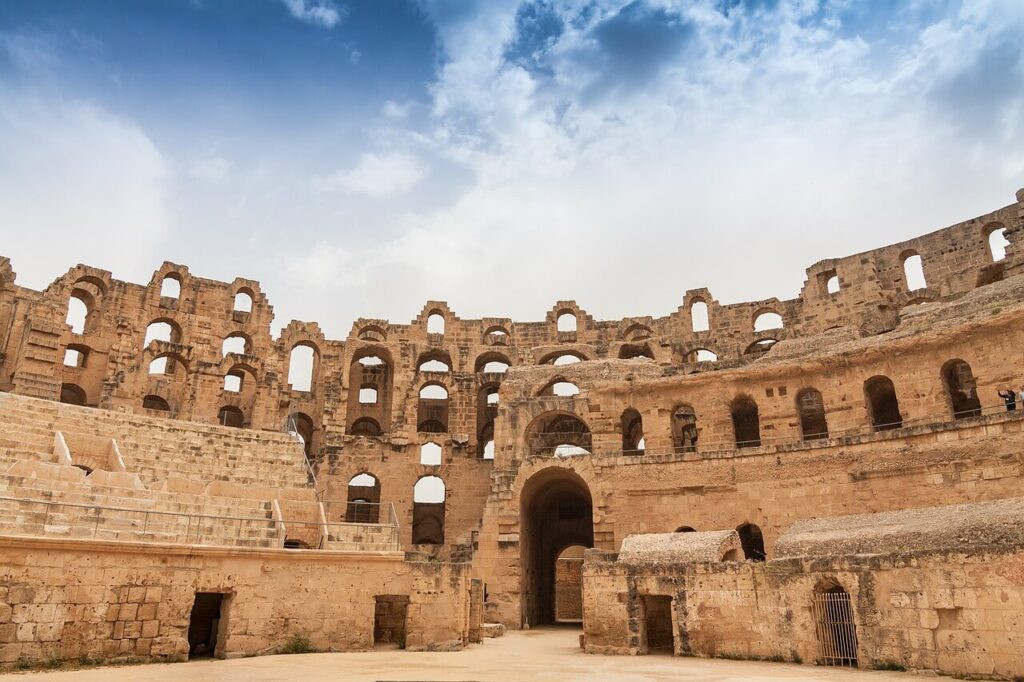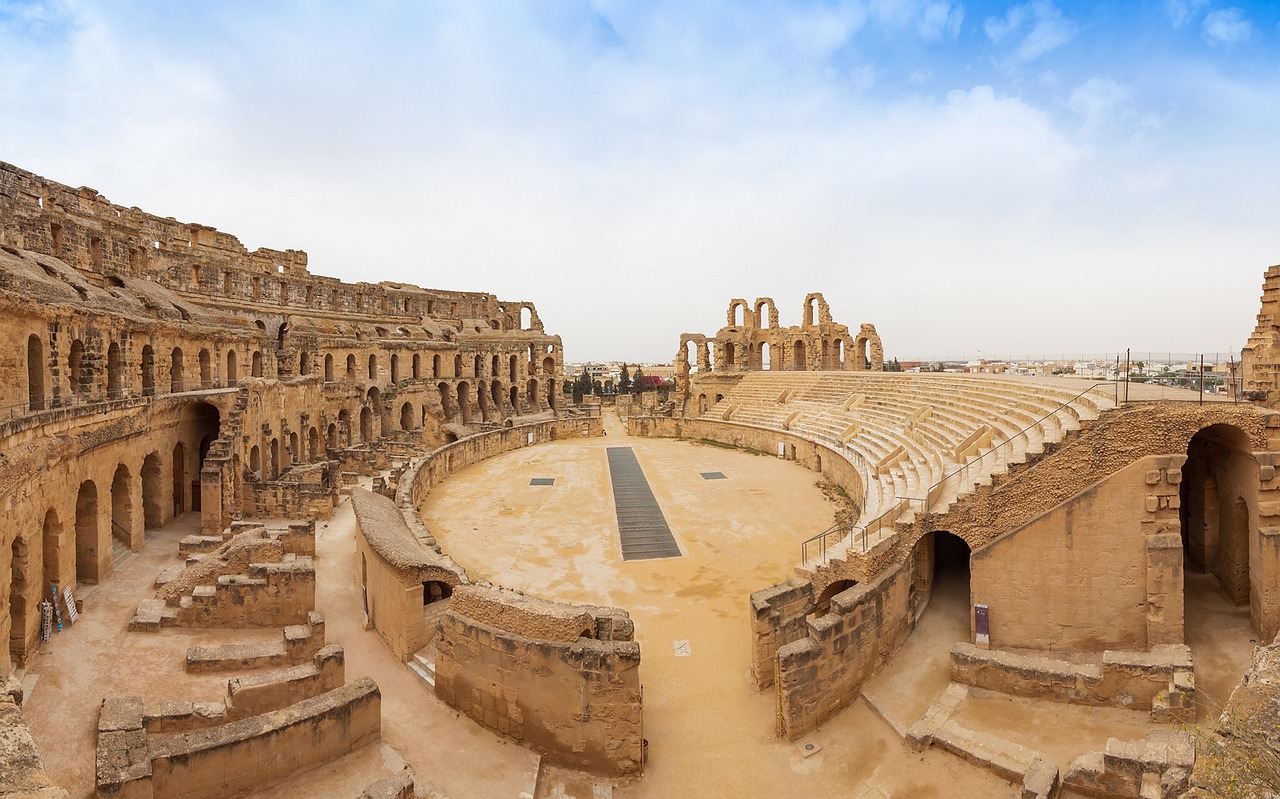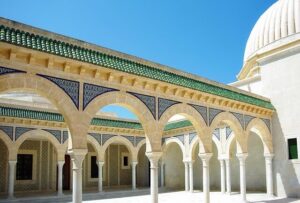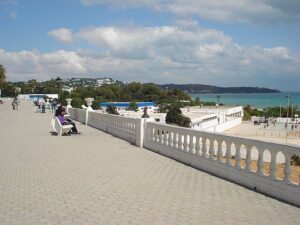Table of Contents
- The Amphitheatre of El Jem
- Other Sites of Interest
- Things to Do and See
- Practical Tips for Visiting
- Conclusion
The Amphitheatre of El Jem: a Marvel of Antiquity
History and Construction of the Amphitheatre
The amphitheater of El Jem is the third largest ever built by the Romans, dating back to the third century AD. Under Emperor Gordian III, the city of Thysdrus, now known as El Jem, became an important center of shows and entertainment, attracting up to 35,000 spectators. The construction symbolizes the power of the city in the ancient Roman province of Africa.
Built in local sandstone, the amphitheater testifies to the engineering mastery of the Romans. The walls and arches, up to 36 meters high, still stand today as a tangible proof of the glorious past of this city. Visitors can see the traces of gladiators, hunters and wild animals that once filled the arena.
Recognized as a UNESCO World Heritage Site, the El Jem amphitheater remains one of the most fascinating places in Tunisia. With its magnificent state of preservation, it is now home to events and the famous Symphonic Music Festival, which celebrates the historical heritage of Tunisia.
Architecture and Conservation
Entirely built with local materials, the El Jem amphitheater has three levels of arches and underground structures. The use of durable materials has helped to preserve it through the centuries, despite looting and weathering. Its unique architecture has made the amphitheater a source of inspiration for scholars and archeology enthusiasts.
The circular arches and underground passages of the amphitheater are among the most impressive elements, designed to facilitate access and management of activities. With a high level of conservation, this architectural masterpiece is one of the most representative places of Roman culture in Tunisia.
The charm of the site also extends to modern use: cultural events and tourist visits allow you to experience the amphitheater as a real bridge with antiquity.
The Amphitheatre Today
The El Jem amphitheater is more than an archaeological site: it is a true cultural institution. It welcomes thousands of tourists, archaeologists and scholars every year who come to admire the structure and discover the history of Tunisia. It also hosts artistic and musical events, including the famous El Jem International Symphonic Music Festival.
Culture lovers can explore the arches and underground passages to live a unique experience, imagining the past in which the arena resounded with shows and celebrations. It is one of the main attractions of Tunisia and cannot be missed in your travel itinerary.
Other Sites of Interest in El Jem
The Archaeological Museum
Located next to the amphitheater, the El Jem Archaeological Museum houses a collection of Roman mosaics, one of the best examples of mosaic art in North Africa. These mosaics depict scenes of daily life, myths and nature, offering a fascinating view of Roman life in Tunisia.
The museum is located in a restored Roman villa, which allows visitors to fully immerse themselves in the atmosphere of the time. The exhibitions are curated to offer an educational and engaging experience, with detailed explanations of the history of the city and its inhabitants.
For history buffs, the museum is an unmissable stop to explore the cultural and artistic heritage of ancient Tunisia.
The Villas and Archaeological Remains
El Jem is surrounded by the remains of numerous Roman villas and ancient structures that tell the ancient splendor of the city of Thysdrus. Among these, the Villa Africa stands out for its splendid mosaics and original layout.
The Roman houses retain traces of the architecture and daily life of the Roman period, offering visitors an immersion in antiquity. There are also remains of roads and public baths that reflect the prosperity and urban organization of El Jem.
Walking through these places, it is easy to understand why El Jem is considered one of the most significant cities of ancient Tunisia.
Things to Do and See in El Jem
Explore the Historic Center
El Jem is not just archeology: the historic center of the city offers an authentic atmosphere, with local markets, shops and unique handicrafts. The narrow streets and traditional houses create a picturesque atmosphere, ideal for those seeking to discover Tunisian culture.
Visitors can buy unique souvenirs, such as ceramics and fabrics, typical of the region. It is also possible to taste the local cuisine, rich in spices and Mediterranean flavors, making El Jem a gastronomic destination.
This combination of history and authenticity makes the historic center a point of reference for those visiting Tunisia.
Excursions in the Surroundings
The strategic position of El Jem makes it ideal for excursions to other historic cities of Tunisia. At a short distance are the coastal city of Sousse and the historic Kairouan, both destinations of great cultural interest.
Sousse offers beaches and a maritime atmosphere, while Kairouan is famous for its mosques and the lively souk. Both cities perfectly complement the trip of those visiting El Jem, allowing them to explore the cultural variety of Tunisia.
The excursions from El Jem are perfect for a complete and rich journey of discovery.
Practical Tips for Visiting El Jem
How to Arrive
The city is well connected thanks to the Tunisian railway network, with direct trains from Tunis and Sfax. The train station is located a short distance from the amphitheater, making El Jem easily accessible for those traveling by train or car.
For those wishing to move independently, the car is an ideal option as it is reachable via the main highway of Tunisia, offering a comfortable and fast journey.
The train station is a few minutes walk from the amphitheater, making the visit easy and convenient even for those arriving by public transport.
When to Visit El Jem
The ideal season to visit it is from March to May and from September to November, when the climate is mild and ideal for exploring the outdoor sites. During the summer months, temperatures can be high, so it is advisable to visit during the cooler hours.
The International Symphonic Music Festival, held every summer in the amphitheater, is a unique opportunity to combine culture and music. During the festival, the atmosphere becomes particularly suggestive, with the classical notes that resonate between the ancient arches.
El Jem is fascinating in every season, but autumn and spring remain the best periods for a complete and comfortable experience.
Conclusion
El Jem is much more than a simple archaeological site: it is a window on the glorious past of Tunisia, a place where history and culture merge. Exploring this ancient Roman city allows you to understand the rich cultural heritage of Tunisia and admire a heritage that has crossed the centuries.
From the amphitheater to the archaeological museum, every corner of this city tells a unique story, inviting visitors to discover and appreciate a fundamental chapter of African and Mediterranean history.
Read also the other our articles.
We leave you a short video on the topic.
Other town:






